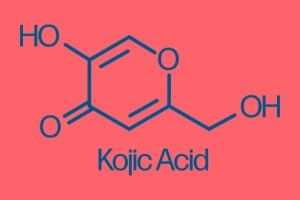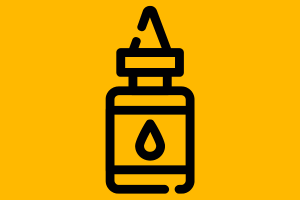Alpha arbutin is a skin-brightening ingredient. It brightens our skin by reducing pigmentation on our face.
How does alpha arbutin work for skin pigmentation?
Some background about the causes of hyperpigmentation
Tyrosinase is an enzyme found in the skin. This enzyme helps in the production of a pigment called melanin.
Melanin has two important functions: it gives skin its colour and protects it from harmful irritants.
When skin is inflammed, it basically means it’s being attacked by irritants. These irritants include the Sun’s UV rays, pollution, cuts, bruises, etc.
So when skin is inflammed (under attack), tyrosinase enzyme springs into action. It gets hyperactive and starts producing more melanin. It does this because it is trying to defend itself – and melanin defends/protects skin.
Unfortunately, not all of the melanin produced is helpful. Melanin can offer protection only up to a certain level. Once that level has been reached, any additional melanin produced is just excess. It can’t provide any protection. However, the tyrosinase enzyme doesn’t realise this. It continues to be hyperactive until the skin is inflammed. It continues to help produce more and more melanin as long as the skin is inflamed. And most of this melanin is just excess.
All this excess melanin gets to the top layer of skin and deposits itself there. Excess melanin deposits have an intense colour that is darker than the surrounding skin. This is what pigmentation is – dark skin in certain sections of the face.
Here is how alpha arbutin reduces pigmentation
Alpha arbutin is a tyrosinase inhibitor.
Alpha arbutin interferes with the activity of the tyrosinase enzyme. This interference reduces the enzyme’s overexcitement.
Reducing the over-excitement of the enzyme means a reduction in melanin over-production.
Once the over-production of melanin reduces/stops, excess melanin deposits reduce, which means pigmentation on the skin reduces/stops.
A quick note: Melanin is essential for the skin. What causes the problem is the overproduction of melanin. This overproduction occurs when the enzyme tyrosinase is overstimulated. Ingredients like alpha arbutin reduce the overstimulation of the enzyme and thus reduce the overproduction of melanin. So, it is important to remember here that we are not reducing melanin production but reducing the overproduction of melanin.
How much alpha arbutin do we need?
It is effective from 0.5% in skincare products and is most effective at 2%.
Alpha Arbutin skincare products usually come in serums or moisturisers. In serums, alpha arbutin is the main ingredient. In moisturisers, it is one of many ingredients. Alpha arbutin can be effective in moisturisers, too, because we don’t need a high concentration of it for it to be effective.
Alpha arbutin and Hydroquinone
Hydroquinone is considered the gold standard in fighting pigmentation. It also works by inhibiting the tyrosinase enzyme and reducing melanin production. Unfortunately, hydroquinone has many side effects. If not administered correctly, it can drastically reduce melanin production. This is not good because melanin is vital in maintaining skin health. To reduce pigmentation, we don’t want to reduce melanin production; we only want to reduce the overproduction of melanin.
Arbutin is a natural form of hydroquinone. When applied on the skin, it gradually and slowly releases hydroquinone. The amount of arbutin used in skin care products will not be able to produce hydroquinone at an amount that can affect the skin. So, this is good news.
Alpha arbutin vs. beta arbutin
There are two types of arbutin: alpha and beta. Beta arbutin is not as effective on the skin as alpha arbutin is.
If skincare products mention just arbutin on their ingredient list, there is a high chance it is beta arbutin. Skincare manufacturers are aware of the benefits of alpha arbutin over beta arbutin. So, if they use alpha arbutin, they will proudly mention alpha arbutin rather than saying just arbutin on their label.
So, always check the label and ensure it is alpha arbutin on the ingredient list.
Which other ingredients does Alpha arbutin work well with?
If you use an alpha arbutin serum, many of us have a common question: What should I pair the serum with? What else can I use on top or underneath my alpha arbutin serum?
The aim is to find ingredients that work synergistically with alpha arbutin. One quick point to remember is that it is not necessary to use these ingredients simultaneously. You can use them in the same routine, but it is not essential. For example, you could use one type in the morning and the other at night.
For best results, it is important to use 2 to 3 different anti-pigmentation ingredients/products, not necessarily in the same routine.
Below, I have listed some ingredients you can use when using alpha arbutin.
Other anti-pigment ingredients
Alpha arbutin, a skin-brightening ingredient, works well with other skin-brightening ingredients. Skin-brightening ingredients brighten skin by reducing pigmentation on the face. Pigmentation dulls skin by causing uneven skin tone. A reduction in pigmentation means a brightened face.
Some of the other good brightening ingredients that alpha arbutin works well with are:
A quick note about Vitamin C
Vitamin C is also a tyrosinase inhibitor. The tyrosinase enzyme needs copper to function well. Vitamin C eats the copper and thus interferes with its activity.
The pure form of vitamin C, ascorbic acid, is difficult to formulate in skincare products. And so many manufacturers use derivatives of vitamin C. Not all vitamin C derivatives are as effective as ascorbic acid in reducing pigmentation. It is important to be aware of this because otherwise, we might wrongly assume every vitamin C product helps fight pigmentation.
Tetrahexyldecyl ascorbate, 3-O ethyl ascorbic acid, and magnesium ascorbyl phosphate are good vitamin C derivatives that can help fight pigmentation.
A quick note about Niacinamide
All the skin-brightening ingredients except niacinamide mentioned above fight pigmentation by being a tyrosinase inhibitor. They inhibit tyrosinase activity in different ways.
Niacinamide, on the other hand, fights pigmentation by reducing the transfer of melanin. Melanin is produced in cells called melanocytes. It then gets transferred into cells called keratinocytes. Keratinocyte cells are the most abundant cells in the top layer of the skin. Sometimes, excess melanin gets transferred to these cells. Niacinamide reduces this transfer.
To fight pigmentation, it helps if we use ingredients that fight pigmentation from different pathways. Alpha arbutin fights by inhibiting tyrosinase. Niacinamide fights by reducing the transfer. Both these ingredients do the same thing but through different pathways.


